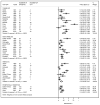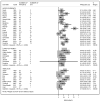Central venous catheter-related thrombosis and thromboprophylaxis in children: a systematic review and meta-analysis
- PMID: 24801495
- PMCID: PMC4107177
- DOI: 10.1111/jth.12598
Central venous catheter-related thrombosis and thromboprophylaxis in children: a systematic review and meta-analysis
Abstract
Objectives: In preparation for a pediatric randomized controlled trial on thromboprophylaxis, we determined the frequency of catheter-related thrombosis in children. We also systematically reviewed the pediatric trials on thromboprophylaxis to evaluate its efficacy and to identify possible pitfalls in the conduct of these trials.
Patients/methods: We searched MEDLINE, EMBASE, Web of Science and the Cochrane Central Register for Controlled Trials for articles published until December 2013. We included cohort studies and trials on patients aged 0-18 years with central venous catheters who underwent active surveillance for thrombosis with radiologic imaging. We estimated the pooled frequency of thrombosis and the pooled risk ratio (RR) with thromboprophylaxis by using a random effects model.
Results: From 2651 articles identified, we analyzed 37 articles with 3128 patients. The pooled frequency of thrombosis was 0.20 (95% confidence interval [CI] 0.16-0.24). In 10 trials, we did not find evidence that heparin-bonded catheters (RR 0.34; 95%CI 0.01-7.68), unfractionated heparin (RR 0.93; 95% CI 0.57-1.51), low molecular weight heparin (RR 1.13; 95% CI 0.51-2.50), warfarin (RR 0.85; 95%CI 0.34-2.17), antithrombin concentrate (RR 0.76; 95% CI 0.38-1.55) or nitroglycerin (RR 1.53; 95%CI 0.57-4.10) reduced the risk of thrombosis. Most of the trials were either not powered for thrombosis or were powered to detect large, probably unachievable, reductions in thrombosis. Missing data on thrombosis also limited these trials.
Conclusions: Catheter-related thrombosis is common in children. An adequately powered multicenter trial that can detect a modest, clinically significant reduction in thrombosis is critically needed. Missing outcome data should be minimized in this trial.
Keywords: anticoagulants; heparin; pediatrics; prevention; prophylaxis.
© 2014 International Society on Thrombosis and Haemostasis.
Figures





Comment in
-
Central venous catheter-related thrombosis and thromboprophylaxis in children: a systematic review and meta-analysis: comment.J Thromb Haemost. 2015 Jan;13(1):160-1. doi: 10.1111/jth.12745. Epub 2014 Dec 6. J Thromb Haemost. 2015. PMID: 25280232 No abstract available.
-
Central venous catheter-related thrombosis and thromboprophylaxis in children: a systematic review and meta-analysis: reply.J Thromb Haemost. 2015 Jan;13(1):161-2. doi: 10.1111/jth.12773. Epub 2014 Dec 6. J Thromb Haemost. 2015. PMID: 25369877 No abstract available.
References
-
- Leavitt MO. The Surgeon General’s Call to Action to Prevent Deep Vein Thrombosis and Pulmonary Embolism. Darby, PA: DIANE Publishing Company; 2009.
-
- Raffini L, Huang YS, Witmer C, Feudtner C. Dramatic increase in venous thromboembolism in children’s hospitals in the United States from 2001 to 2007. Pediatrics. 2009;124:1001–8. - PubMed
-
- Raffini L, Trimarchi T, Beliveau J, Davis D. Thromboprophylaxis in a pediatric hospital: A patient-safety and quality-improvement initiative. Pediatrics. 2011;127:e1326–32. - PubMed
-
- Hanson SJ, Punzalan RC, Arca MJ, Simpson P, Christensen MA, Hanson SK, Yan K, Braun K, Havens PL. Effectiveness of clinical guidelines for deep vein thrombosis prophylaxis in reducing the incidence of venous thromboembolism in critically ill children after trauma. J Trauma Acute Care Surg. 2012;72:1292–7. - PubMed
Publication types
MeSH terms
Substances
Grants and funding
LinkOut - more resources
Full Text Sources
Other Literature Sources
Medical

